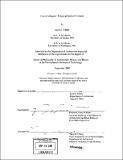| dc.contributor.advisor | Nasser Rabbat. | en_US |
| dc.contributor.author | Tohme, Lara G | en_US |
| dc.contributor.other | Massachusetts Institute of Technology. Dept. of Architecture. | en_US |
| dc.date.accessioned | 2008-02-28T16:15:42Z | |
| dc.date.available | 2008-02-28T16:15:42Z | |
| dc.date.issued | 2005 | en_US |
| dc.identifier.uri | http://dspace.mit.edu/handle/1721.1/33740 | en_US |
| dc.identifier.uri | http://hdl.handle.net/1721.1/33740 | |
| dc.description | Thesis (Ph. D.)--Massachusetts Institute of Technology, Dept. of Architecture, 2005. | en_US |
| dc.description | "September 2005." | en_US |
| dc.description | Includes bibliographical references (leaves 197-223). | en_US |
| dc.description.abstract | This dissertation explores the relationship between the art and architecture of the early Islamic period to those of pre-Islamic Bilad al-Sham (the region encompassing the modem-day countries of Syria, Jordan, Lebanon, Palestine and Israel), and focuses on the Umayyad bathhouse as a paradigm through which this relationship is articulated. The visual culture of the Umayyad dynasty (661-750CE) is of extreme importance, not only because it constitutes the foundation of Islamic art and architecture, but more importantly because it serves as the main link in the chain of cultural transmission from the Greco- Roman and Byzantine worlds to the Medieval Islamic world. The first section of this dissertation explores the ways in which this relationship has been studied as well as the nature of the primary sources, and suggests a new method of how best to study and understand Umayyad art and architecture and their relationship to precedent and contemporaneous cultures. The second section examines the cultural, architectural and political changes in Bilad al-Sham between the fourth and eighth centuries CE, and how the events of these four centuries shaped the art, architecture and culture of the Umayyads. | en_US |
| dc.description.abstract | (cont.) The third and fourth sections concentrate on transformation of the shape and function of the bathhouse in late antiquity, and how the bathhouse was adapted to fit the needs of both pre-Islamic and Islamic late antique cultures in this region. This study concludes by suggesting that Umayyad architecture and culture can best be understood only when interpreted as part of the rich regional and cultural milieu of late antique Bilad al-Sham. | en_US |
| dc.description.statementofresponsibility | by Lara G. Tohme. | en_US |
| dc.format.extent | 223 leaves | en_US |
| dc.language.iso | eng | en_US |
| dc.publisher | Massachusetts Institute of Technology | en_US |
| dc.rights | M.I.T. theses are protected by copyright. They may be viewed from this source for any purpose, but reproduction or distribution in any format is prohibited without written permission. See provided URL for inquiries about permission. | en_US |
| dc.rights.uri | http://dspace.mit.edu/handle/1721.1/33740 | en_US |
| dc.rights.uri | http://dspace.mit.edu/handle/1721.1/7582 | |
| dc.subject | Architecture. | en_US |
| dc.title | Out of antiquity : Umayyad baths in context | en_US |
| dc.title.alternative | Umayyad baths in context | en_US |
| dc.type | Thesis | en_US |
| dc.description.degree | Ph.D. | en_US |
| dc.contributor.department | Massachusetts Institute of Technology. Department of Architecture | |
| dc.identifier.oclc | 65177321 | en_US |
